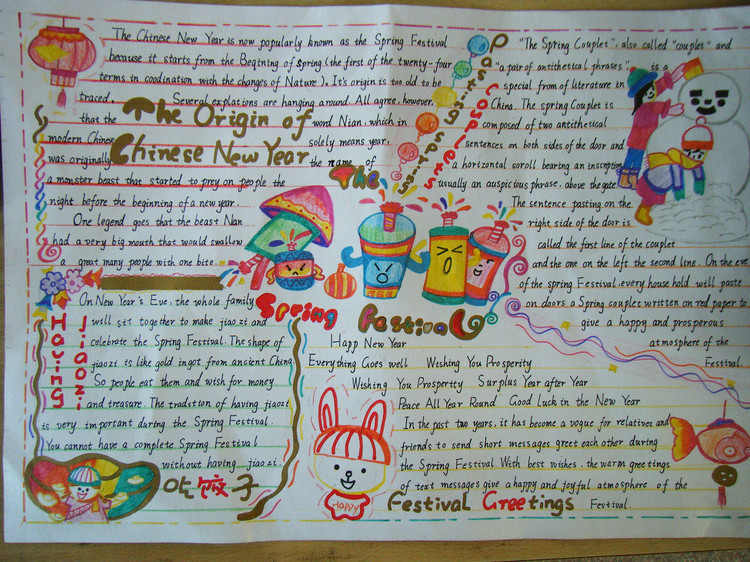【www.myl5520.com--英语教案】
英语新年手抄报【一】
英语版元旦手抄报
以下是小编整理的英语版元旦手抄报图片及内容,欢迎大家浏览参考。更多相关内容请关注手抄报栏目。
Good luck, good health, hood cheer. I wish you a happy New Year.
祝好运、健康、佳肴伴你度过一个快乐新年。
With best wishes for a happy New Year!
祝新年快乐,并致以良好的祝福。
I hope you have a most happy and prosperous New Year.
谨祝新年快乐幸福,大吉大利。
With the compliments of the season.
祝贺佳节。
May the season"s joy fill you all the year round.
愿节日的愉快伴你一生。
Season"s greetings and best wishes for the New Year.
祝福您,新年快乐。
Please accept my season"s greetings.
请接受我节日的祝贺。
To wish you joy at this holy season. Wishing every happiness will always bewith you.
恭祝新年吉祥,幸福和欢乐与你同在。
Good health, good luck and much happiness throughout the year.
恭祝健康、幸运,新年快乐。
May the joy and happiness around you today and always.
愿快乐幸福永伴你左右。
Please accept my sincere wishes for the New Year. I hope you will continueto enjoy good health.
请接受我诚挚的新年祝福,顺祝身体健康。
Allow me to congratulate you on the arrival of the New Year and to extend toyou all my best wishes for your perfect health and lasting prosperity.
恭贺新禧,祝身体健康、事业发达。

Best wishes for the holidays and happiness throughout the New Year.
恭贺新禧,万事如意。
Hope you will join with me in bringing in the new spring.
愿和你一起迎春接福。
The coming of spring means the coming of new hopes.
春天的来临,象征新希望的到来。
May you have many dreams fulfilled.
祝你许多美梦都能成真。

We wish you a renewed hope in life.
我们祝福你再度燃起生命的希望。
Please join us to light off firecrackers.

让我们一起来燃放爆竹除旧岁。
We hope your family and my family can get together for a celebration like last year.
我们希望你们全家与我们家能像去年一样,聚在一起共同庆祝新年。
Wishing you and your family peace and prosperity for the coming year.
祝福你与家人吉祥平安。
英语新年手抄报【二】
春节英语手抄报内容
下面是提供的春节英语手抄报内容,欢迎阅读。
春节英语手抄报(一)英语新年手抄报。
春节英语手抄报(二)
春节英语手抄报(三)
英语新年手抄报。
春节英语手抄报(四)
春节英语手抄报(五)
春节英语手抄报(六)
春节英语手抄报内容
The Origin of Chinese New Year
the Chinese New Year is now popularly known as the Spring Festival because it starts from the Begining of Spring (the first of the twenty-four terms in coodination with the changes of Nature). Its origin is too old to be traced. Several explanations are hanging around. All aGREe, however, that the word Nian, which in modern Chinese solely means "year", was originally the name of a monster beast that started to prey on people the night before the beginning of a new year.
One legend goes that the beast Nian had a very big mouth that would swallow a GREat many people with one bite. People were very scared. One day, an old man came to their rescue, offering to subdue Nian. To Nian he said, "I hear say that you are very capable, but can you swallow the other beasts of prey on earth instead of people who are by no means of your worthy opponents?" So, it did swallow many of the beasts of prey on earth that also harrassed people and their domestic animals from time to time.
After that, the old man disappeared riding the beast Nian. He turned out to be an immortal god. Now that Nian is gone and other beasts of prey are also scared into forests, people begin to enjoy their peaceful life. Before the old man left, he had told people to put up red paper decorations on their windows and doors at each year"s end to scare away Nian in case it sneaked back again, because red is the color the beast feared the most.
From then on, the tradition of observing the conquest of Nian is carried on from generation to generation. The term "Guo Nian", which may mean "Survive the Nian" becomes today "Celebrate the (New) Year" as the word "guo" in Chinese having both the meaning of "pass-over" and "observe". The custom of putting up red paper and firing fire-crackers to scare away Nian should it have a chance to run loose is still around. However, people today have long forgotten why they are doing all this, except that they feel the color and the sound add to the excitement of the celebration.
中国春节的由来
春节源自何时很难考究,不过一般认为起源于中国殷商时期的年头岁末祭神、祭祖活动(腊祭);传说最早在尧舜时就有过春节的风俗。农历的正月是一年的开始,而正月上旬或中旬,大部分情况正好是春季的开始(少部分情况立春是在农历腊月下旬)。节日的时间相信和农业劳作影响有关;甲骨文和金文中的年字都有谷穗成熟的形象。
“年”的甲骨文写法为上面部分为“禾”字,下面部分为“人”字。金文的“年”字也与甲骨文相同也从禾、从人。小篆的“年”写作“上禾下千”,《说文解字·禾部》;“年”字下面的“人”字又作何解释呢?从甲骨文看,“年”字好像是人头上顶着谷物。
还有一种传说:
中国古时候有一种叫“年”的兽,头长触角,凶猛异常。“年”长年深居海底,每到除夕才爬上岸,吞食牲畜伤害人命。因此,每到除夕这天,村村寨寨的人们扶老携幼逃往深山,以躲避“年”兽的伤害。有一年除夕,从村外来了个乞讨的老人。乡亲们一片匆忙恐慌景象,只有村东头一位老婆婆给了老人些食物,并劝他快上山躲避“年”兽,那老人把胡子撩起来笑道:“婆婆若让我在家呆一夜,我一定把‘年"兽赶走。”老婆婆继续劝说,乞讨老人笑而不语。
半夜时分,“年”兽闯进村。它发现村里气氛与往年不同:村东头老婆婆家,门贴大红纸,屋内烛火通明。“年”兽浑身一抖,怪叫了一声。将近门口时,院内突然传来“砰砰啪啪”的炸响声,“年”浑身战栗,再不敢往前凑了。原来,“年”最怕红色、火光和炸响。这时,婆婆的家门大开,只见院内一位身披红袍的老人在哈哈大笑。“年”大惊失色,狼狈逃蹿了。第二天是正月初一,避难回来的人们见村里安然无恙,十分惊奇。这时,老婆婆才恍然大悟,赶忙向乡亲们述说了乞讨老人的许诺。这件事很快在周围村里传开了,人们都知道了驱赶“年”兽的办法。从此每年除夕,家家贴红对联、燃放爆竹;户户烛火通明、守更待岁。初一一大早,还要走亲串友道喜问好。这风俗越传越广,成了中国民间最隆重的传统节日。
另外还有一种说法:
古时候,有一种叫“年”的野兽,比现在的大象还大几倍,比老虎还凶几十倍。专门吃人,而且一吃就是几十个人,被它吃的人数也数不过来。老百姓可遭了殃。有一天,“年”又来了,有个年轻人恨极了,说:“与其让它吃掉,还不如和它拼了,反正都是一死。”他拿把劈斧冲了上去,好多年轻人也跟着冲了上去。可他们不是“年”的对手,年轻人都被“年”吃掉了。此后,“年”变得更凶恶了,老百姓个个怨气冲天,恨声震地。
冲天的怨气惊动了天上的太白金星,震地的恨声惊动了地下的地王菩萨。太白金星和地王菩萨一商量,就派神农老祖到大地收“年”。神农手执打兽鞭,对准“年”的屁股就是一鞭。凶猛的“年”竟乖乖伏地不动了。神农奔上几步,一只脚踏在“年”头上,怒吼道:“畜牲,你吃人无数,作孽极深,今天你的末日到了。”说罢,从腰间拿下两片瓜钵,对准“年”就一合。比象还大的“年”竟一下合在瓜钵里了。神农把装 “年”的钵埋在地底下,临走时他再三叮嘱说:“这钵埋在地下,将来会长出瓜来,这瓜不能破,一定要说它不破。”后来,那个埋钵的地方真的长出瓜来,百姓就按照神农“不”的话音,把它叫成“北瓜”。神农除“年”的那天正巧是农历十二月三十日,百姓便把这一天叫做“过年”,即避过“年”和除去“年”的意思。这天,北瓜供在堂上,以示压邪,并敲锣打鼓,鸣竹张灯,以纪念神农老祖的功德。 大概是后人根据年俗传统附会的。不太可能是“年”的起源。
古时春节曾专指二十四节气中的立春,也被视为一年的开始。后来改为夏历正月初一(农历正月初一)开始为岁首。从明代开始,新年节日一般要到正月十五日(元宵节)之后才结束,有些地方的新年庆祝活动甚至到整个正月结束为止。春节入选中国世界纪录协会中国最大的节日。位居中国三大传统节日春节、端午节、中秋节之首。
中华民国成立后,民国政府废除传统农历(阴历,实为阴阳历)改行欧洲的格利高里历(阳历),曾试图禁止人民庆祝农历新年,但因民间的坚持而未果。在袁世凯主政期间,将格利高里历的1月1日定为新年元旦,以农历正月初一为“春节”,但老百姓照旧“过新年”,作家们照旧以“过元旦”来称呼过农历新年。
“春节”一词真正广为流行还是在1949年中华人民共和国建立之后,农历新年现在也被称为农历年、旧历年。日本阴历天保暦在明治维新后明治6年(1873年)1月1日起停用,改用太阳历计日,原来的阴历便称之为旧暦,人民的庆祝活动也只在西历元日起的三天国定假日,虽然如此,日本人仍然依照传统习俗过年,只是更改过年的日期,把过年的传统习俗改为格里历新年进行,但原琉球国领地冲绳县以及奄美诸岛等地区仍有旧正月的庆祝活动。同样受中华文化影响的如韩国及越南,即使官方历法改用了西历,官方及民间仍然有农历春节的庆祝活动。
推荐阅读:春节手抄报图片与资料